Reduction of Health Impact: Indoor Air Pollution at KPJ Johor
VerifiedAdded on 2022/11/26
|16
|3505
|346
Report
AI Summary
This report presents a comprehensive analysis of indoor air quality (IAQ) at KPJ Johor Specialist Hospital. The study investigates various aspects of the hospital's environment, including building orientation, existing elements, and potential sources of air pollution. The research encompasses the assessment of key air quality parameters such as carbon monoxide, carbon dioxide, temperature, relative humidity, and particulate matter across different hospital locations, including surgical wards, medical wards, and lobby areas. The findings reveal specific issues, such as elevated carbon dioxide levels and inadequate air movement in certain areas, along with the presence of dust accumulation in ventilation systems. The report includes detailed observations and measurements, comparing them with established IAQ standards. Furthermore, the report provides specific recommendations for improving IAQ, such as enhancing ventilation, cleaning filters, and addressing moisture issues, to mitigate the health impacts of indoor air pollution and ensure a healthier environment for patients and staff. The report concludes with a discussion on the immediate and long-term health effects of indoor air pollution, emphasizing the importance of implementing effective control measures to create a safer and more comfortable indoor environment.
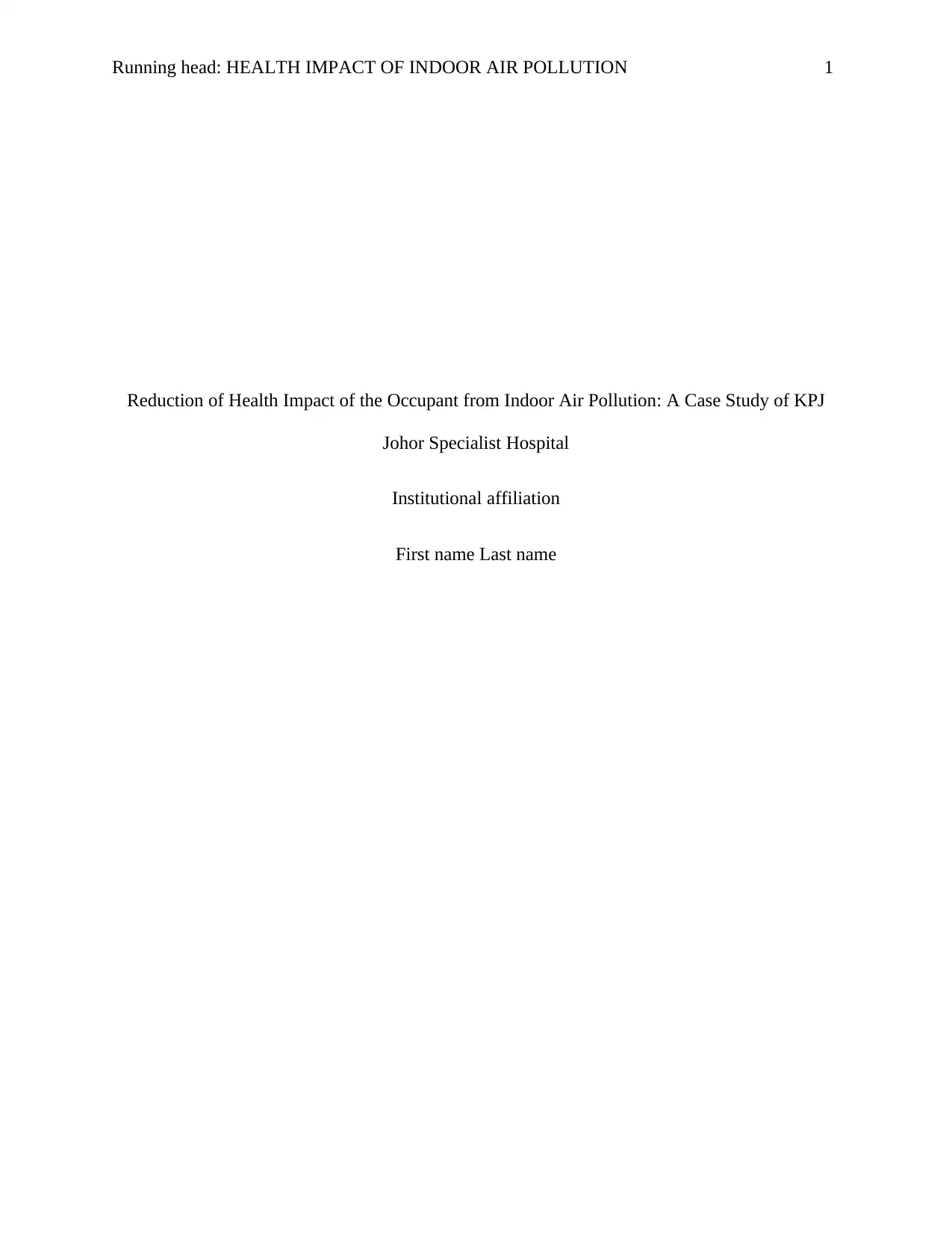
Running head: HEALTH IMPACT OF INDOOR AIR POLLUTION 1
Reduction of Health Impact of the Occupant from Indoor Air Pollution: A Case Study of KPJ
Johor Specialist Hospital
Institutional affiliation
First name Last name
Reduction of Health Impact of the Occupant from Indoor Air Pollution: A Case Study of KPJ
Johor Specialist Hospital
Institutional affiliation
First name Last name
Paraphrase This Document
Need a fresh take? Get an instant paraphrase of this document with our AI Paraphraser
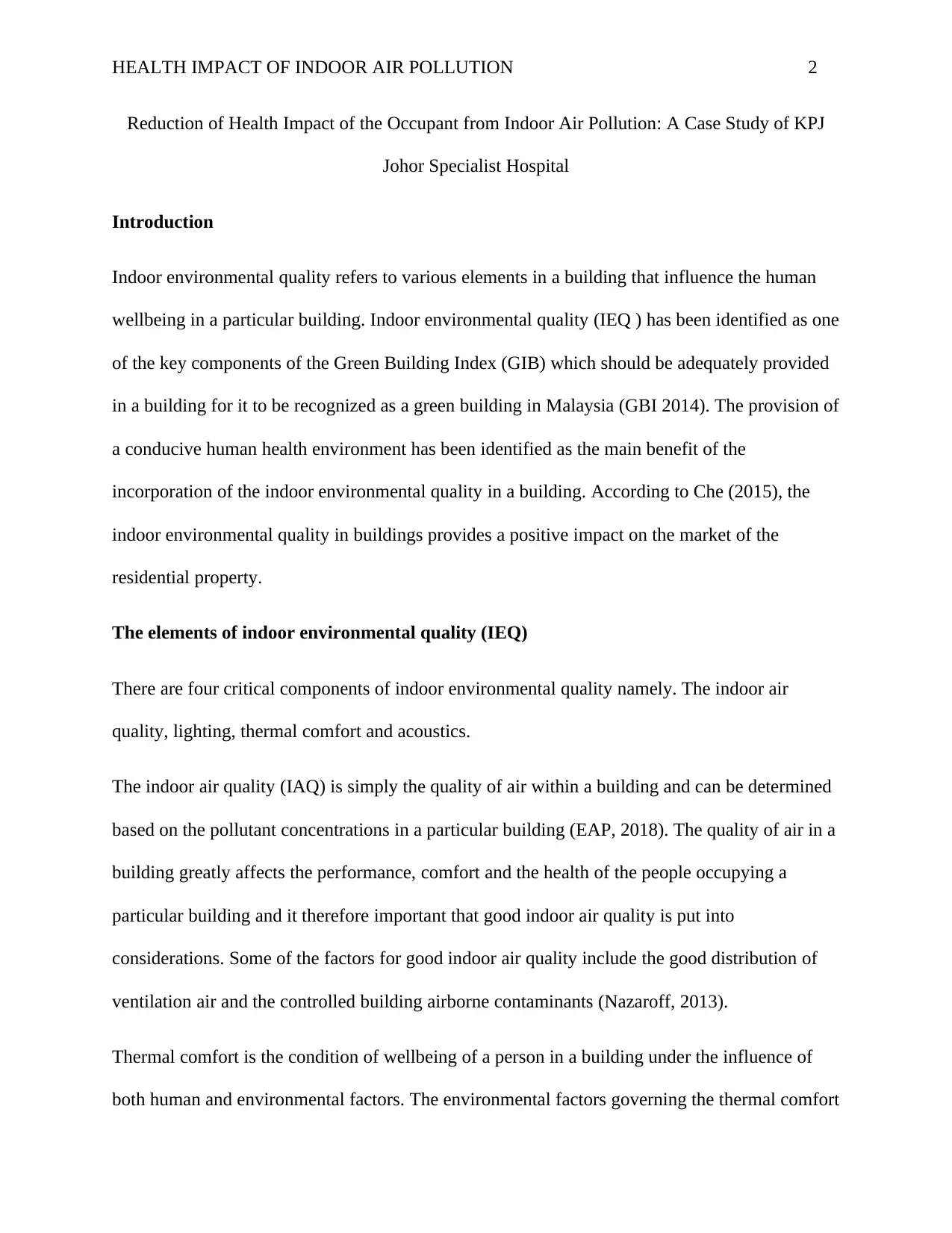
HEALTH IMPACT OF INDOOR AIR POLLUTION 2
Reduction of Health Impact of the Occupant from Indoor Air Pollution: A Case Study of KPJ
Johor Specialist Hospital
Introduction
Indoor environmental quality refers to various elements in a building that influence the human
wellbeing in a particular building. Indoor environmental quality (IEQ ) has been identified as one
of the key components of the Green Building Index (GIB) which should be adequately provided
in a building for it to be recognized as a green building in Malaysia (GBI 2014). The provision of
a conducive human health environment has been identified as the main benefit of the
incorporation of the indoor environmental quality in a building. According to Che (2015), the
indoor environmental quality in buildings provides a positive impact on the market of the
residential property.
The elements of indoor environmental quality (IEQ)
There are four critical components of indoor environmental quality namely. The indoor air
quality, lighting, thermal comfort and acoustics.
The indoor air quality (IAQ) is simply the quality of air within a building and can be determined
based on the pollutant concentrations in a particular building (EAP, 2018). The quality of air in a
building greatly affects the performance, comfort and the health of the people occupying a
particular building and it therefore important that good indoor air quality is put into
considerations. Some of the factors for good indoor air quality include the good distribution of
ventilation air and the controlled building airborne contaminants (Nazaroff, 2013).
Thermal comfort is the condition of wellbeing of a person in a building under the influence of
both human and environmental factors. The environmental factors governing the thermal comfort
Reduction of Health Impact of the Occupant from Indoor Air Pollution: A Case Study of KPJ
Johor Specialist Hospital
Introduction
Indoor environmental quality refers to various elements in a building that influence the human
wellbeing in a particular building. Indoor environmental quality (IEQ ) has been identified as one
of the key components of the Green Building Index (GIB) which should be adequately provided
in a building for it to be recognized as a green building in Malaysia (GBI 2014). The provision of
a conducive human health environment has been identified as the main benefit of the
incorporation of the indoor environmental quality in a building. According to Che (2015), the
indoor environmental quality in buildings provides a positive impact on the market of the
residential property.
The elements of indoor environmental quality (IEQ)
There are four critical components of indoor environmental quality namely. The indoor air
quality, lighting, thermal comfort and acoustics.
The indoor air quality (IAQ) is simply the quality of air within a building and can be determined
based on the pollutant concentrations in a particular building (EAP, 2018). The quality of air in a
building greatly affects the performance, comfort and the health of the people occupying a
particular building and it therefore important that good indoor air quality is put into
considerations. Some of the factors for good indoor air quality include the good distribution of
ventilation air and the controlled building airborne contaminants (Nazaroff, 2013).
Thermal comfort is the condition of wellbeing of a person in a building under the influence of
both human and environmental factors. The environmental factors governing the thermal comfort
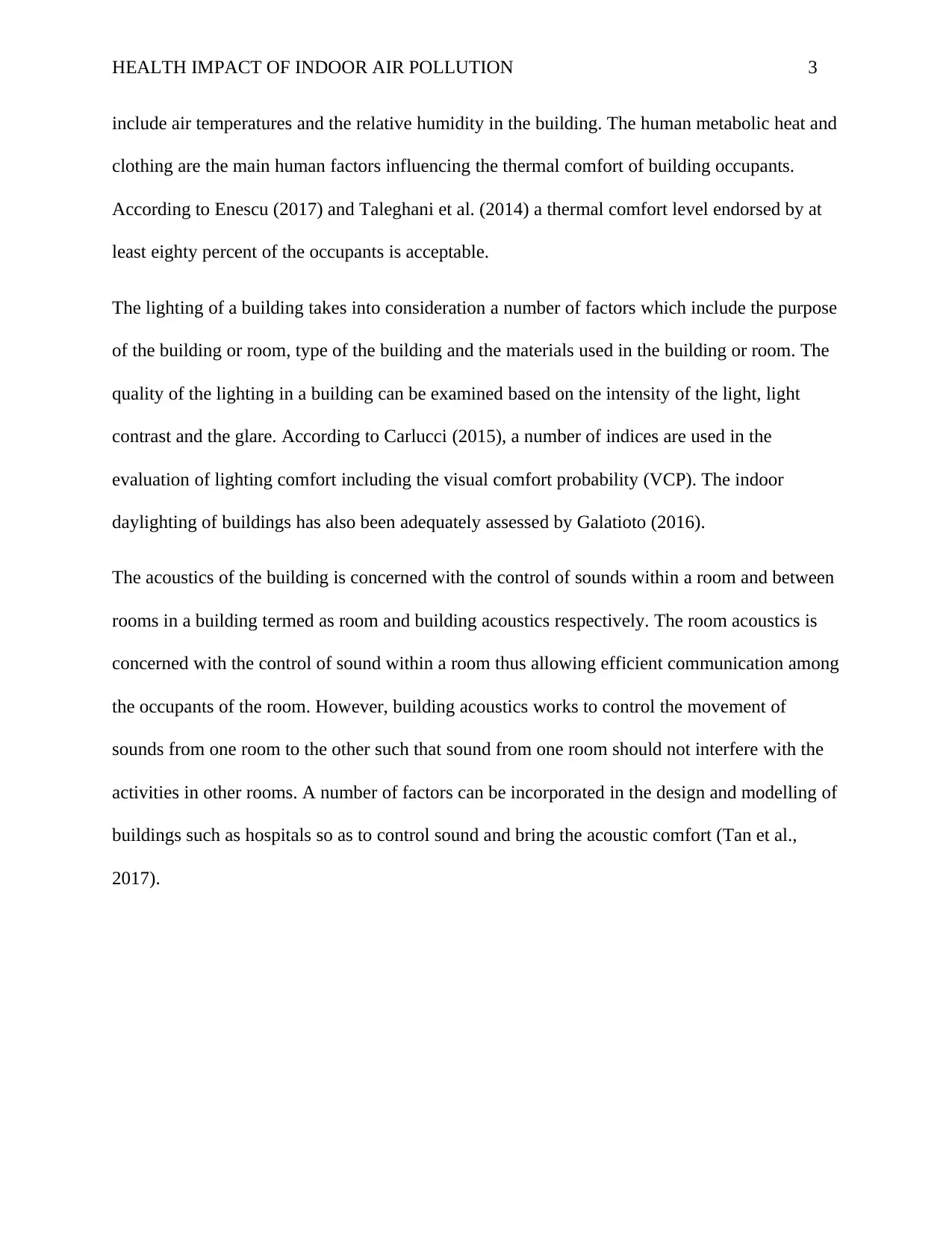
HEALTH IMPACT OF INDOOR AIR POLLUTION 3
include air temperatures and the relative humidity in the building. The human metabolic heat and
clothing are the main human factors influencing the thermal comfort of building occupants.
According to Enescu (2017) and Taleghani et al. (2014) a thermal comfort level endorsed by at
least eighty percent of the occupants is acceptable.
The lighting of a building takes into consideration a number of factors which include the purpose
of the building or room, type of the building and the materials used in the building or room. The
quality of the lighting in a building can be examined based on the intensity of the light, light
contrast and the glare. According to Carlucci (2015), a number of indices are used in the
evaluation of lighting comfort including the visual comfort probability (VCP). The indoor
daylighting of buildings has also been adequately assessed by Galatioto (2016).
The acoustics of the building is concerned with the control of sounds within a room and between
rooms in a building termed as room and building acoustics respectively. The room acoustics is
concerned with the control of sound within a room thus allowing efficient communication among
the occupants of the room. However, building acoustics works to control the movement of
sounds from one room to the other such that sound from one room should not interfere with the
activities in other rooms. A number of factors can be incorporated in the design and modelling of
buildings such as hospitals so as to control sound and bring the acoustic comfort (Tan et al.,
2017).
include air temperatures and the relative humidity in the building. The human metabolic heat and
clothing are the main human factors influencing the thermal comfort of building occupants.
According to Enescu (2017) and Taleghani et al. (2014) a thermal comfort level endorsed by at
least eighty percent of the occupants is acceptable.
The lighting of a building takes into consideration a number of factors which include the purpose
of the building or room, type of the building and the materials used in the building or room. The
quality of the lighting in a building can be examined based on the intensity of the light, light
contrast and the glare. According to Carlucci (2015), a number of indices are used in the
evaluation of lighting comfort including the visual comfort probability (VCP). The indoor
daylighting of buildings has also been adequately assessed by Galatioto (2016).
The acoustics of the building is concerned with the control of sounds within a room and between
rooms in a building termed as room and building acoustics respectively. The room acoustics is
concerned with the control of sound within a room thus allowing efficient communication among
the occupants of the room. However, building acoustics works to control the movement of
sounds from one room to the other such that sound from one room should not interfere with the
activities in other rooms. A number of factors can be incorporated in the design and modelling of
buildings such as hospitals so as to control sound and bring the acoustic comfort (Tan et al.,
2017).
⊘ This is a preview!⊘
Do you want full access?
Subscribe today to unlock all pages.

Trusted by 1+ million students worldwide
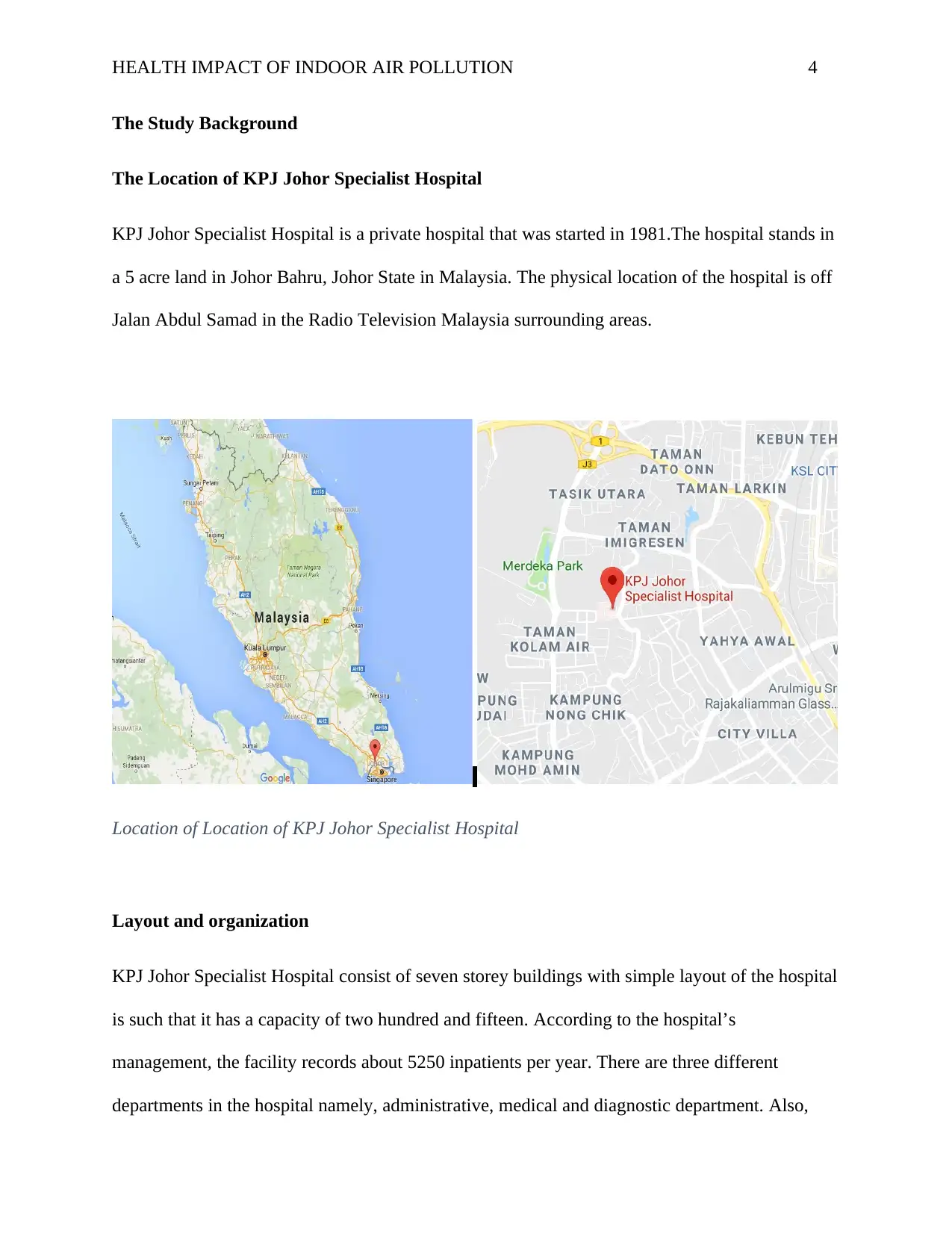
HEALTH IMPACT OF INDOOR AIR POLLUTION 4
The Study Background
The Location of KPJ Johor Specialist Hospital
KPJ Johor Specialist Hospital is a private hospital that was started in 1981.The hospital stands in
a 5 acre land in Johor Bahru, Johor State in Malaysia. The physical location of the hospital is off
Jalan Abdul Samad in the Radio Television Malaysia surrounding areas.
Location of Location of KPJ Johor Specialist Hospital
Layout and organization
KPJ Johor Specialist Hospital consist of seven storey buildings with simple layout of the hospital
is such that it has a capacity of two hundred and fifteen. According to the hospital’s
management, the facility records about 5250 inpatients per year. There are three different
departments in the hospital namely, administrative, medical and diagnostic department. Also,
The Study Background
The Location of KPJ Johor Specialist Hospital
KPJ Johor Specialist Hospital is a private hospital that was started in 1981.The hospital stands in
a 5 acre land in Johor Bahru, Johor State in Malaysia. The physical location of the hospital is off
Jalan Abdul Samad in the Radio Television Malaysia surrounding areas.
Location of Location of KPJ Johor Specialist Hospital
Layout and organization
KPJ Johor Specialist Hospital consist of seven storey buildings with simple layout of the hospital
is such that it has a capacity of two hundred and fifteen. According to the hospital’s
management, the facility records about 5250 inpatients per year. There are three different
departments in the hospital namely, administrative, medical and diagnostic department. Also,
Paraphrase This Document
Need a fresh take? Get an instant paraphrase of this document with our AI Paraphraser
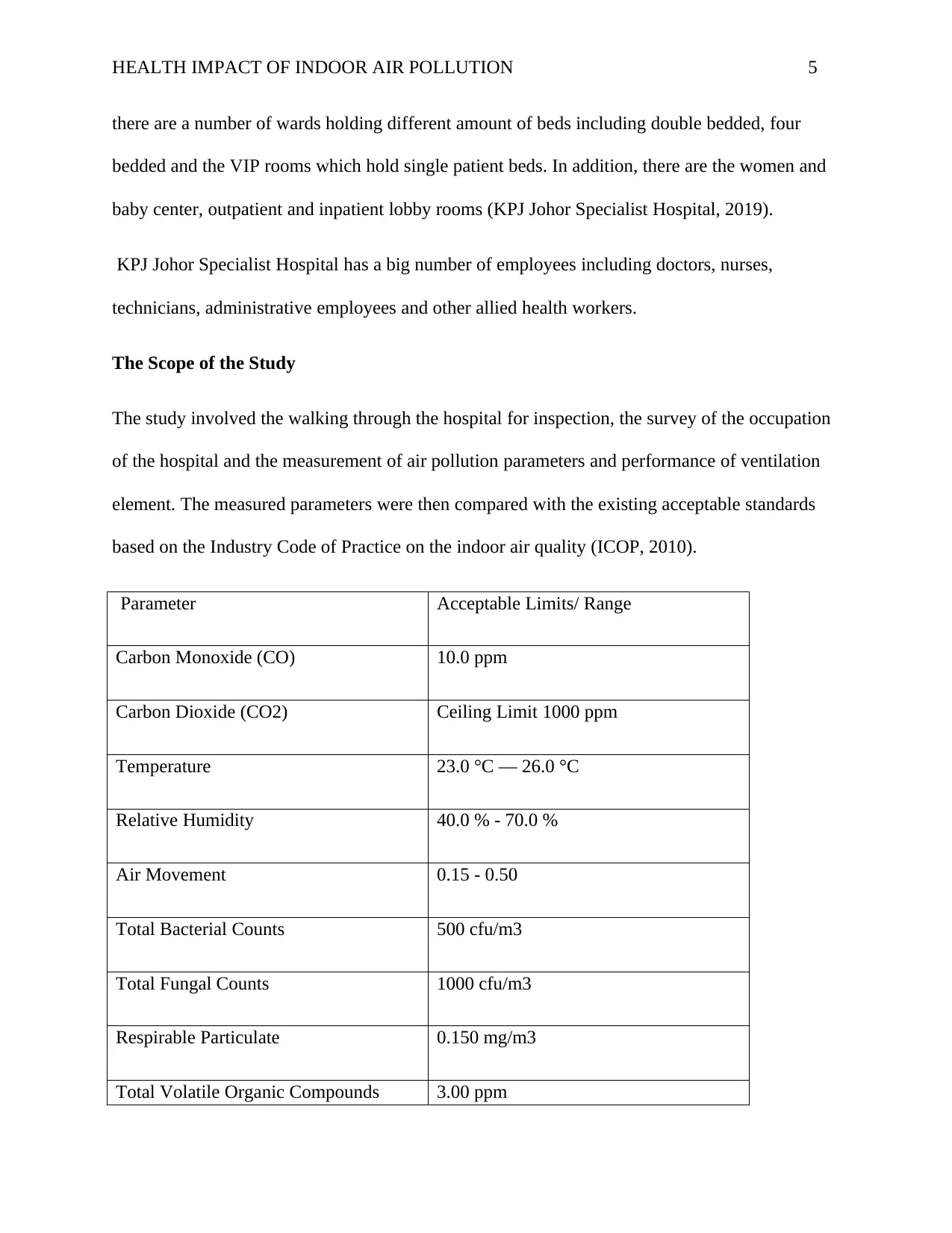
HEALTH IMPACT OF INDOOR AIR POLLUTION 5
there are a number of wards holding different amount of beds including double bedded, four
bedded and the VIP rooms which hold single patient beds. In addition, there are the women and
baby center, outpatient and inpatient lobby rooms (KPJ Johor Specialist Hospital, 2019).
KPJ Johor Specialist Hospital has a big number of employees including doctors, nurses,
technicians, administrative employees and other allied health workers.
The Scope of the Study
The study involved the walking through the hospital for inspection, the survey of the occupation
of the hospital and the measurement of air pollution parameters and performance of ventilation
element. The measured parameters were then compared with the existing acceptable standards
based on the Industry Code of Practice on the indoor air quality (ICOP, 2010).
Parameter Acceptable Limits/ Range
Carbon Monoxide (CO) 10.0 ppm
Carbon Dioxide (CO2) Ceiling Limit 1000 ppm
Temperature 23.0 °C — 26.0 °C
Relative Humidity 40.0 % - 70.0 %
Air Movement 0.15 - 0.50
Total Bacterial Counts 500 cfu/m3
Total Fungal Counts 1000 cfu/m3
Respirable Particulate 0.150 mg/m3
Total Volatile Organic Compounds 3.00 ppm
there are a number of wards holding different amount of beds including double bedded, four
bedded and the VIP rooms which hold single patient beds. In addition, there are the women and
baby center, outpatient and inpatient lobby rooms (KPJ Johor Specialist Hospital, 2019).
KPJ Johor Specialist Hospital has a big number of employees including doctors, nurses,
technicians, administrative employees and other allied health workers.
The Scope of the Study
The study involved the walking through the hospital for inspection, the survey of the occupation
of the hospital and the measurement of air pollution parameters and performance of ventilation
element. The measured parameters were then compared with the existing acceptable standards
based on the Industry Code of Practice on the indoor air quality (ICOP, 2010).
Parameter Acceptable Limits/ Range
Carbon Monoxide (CO) 10.0 ppm
Carbon Dioxide (CO2) Ceiling Limit 1000 ppm
Temperature 23.0 °C — 26.0 °C
Relative Humidity 40.0 % - 70.0 %
Air Movement 0.15 - 0.50
Total Bacterial Counts 500 cfu/m3
Total Fungal Counts 1000 cfu/m3
Respirable Particulate 0.150 mg/m3
Total Volatile Organic Compounds 3.00 ppm
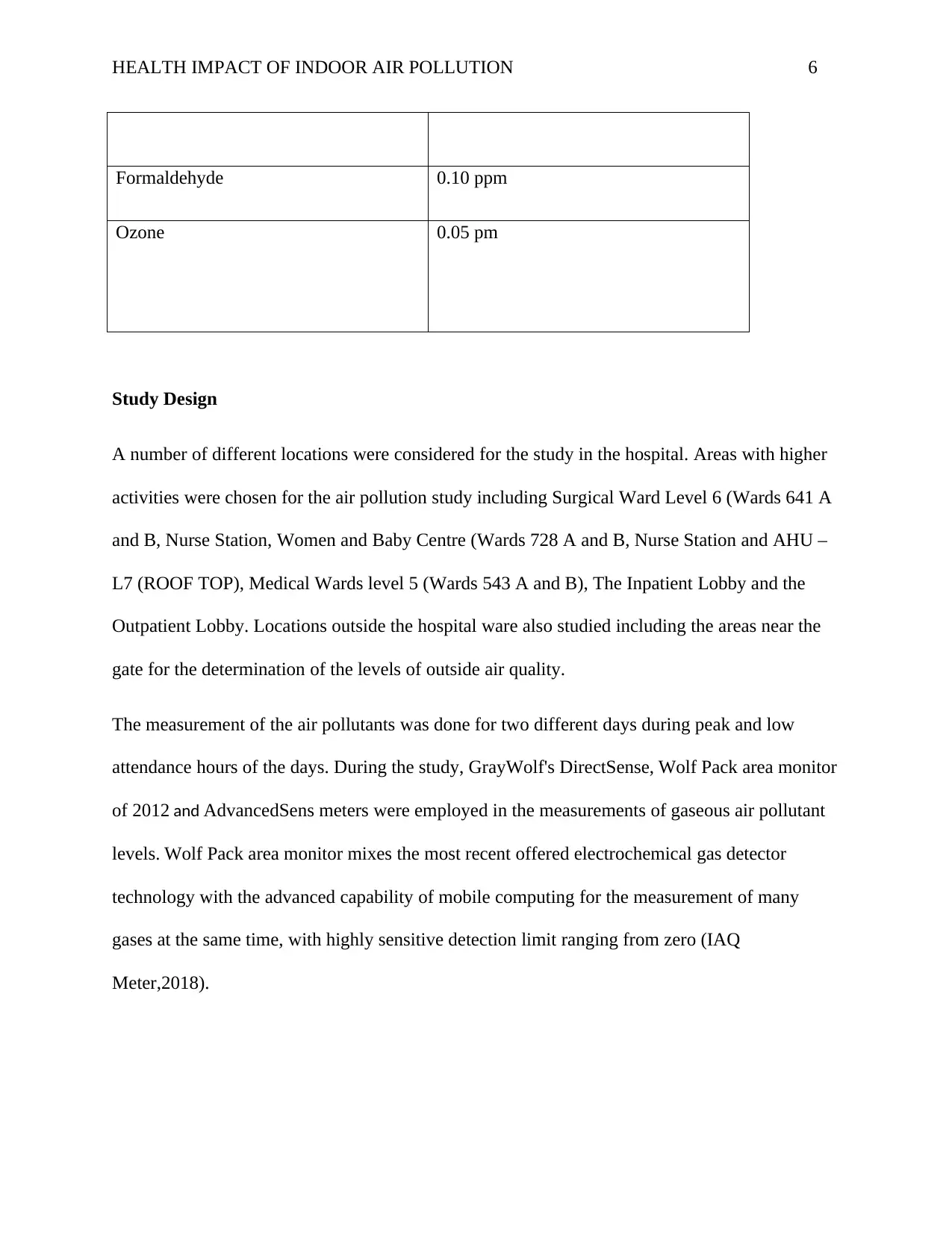
HEALTH IMPACT OF INDOOR AIR POLLUTION 6
Formaldehyde 0.10 ppm
Ozone 0.05 pm
Study Design
A number of different locations were considered for the study in the hospital. Areas with higher
activities were chosen for the air pollution study including Surgical Ward Level 6 (Wards 641 A
and B, Nurse Station, Women and Baby Centre (Wards 728 A and B, Nurse Station and AHU –
L7 (ROOF TOP), Medical Wards level 5 (Wards 543 A and B), The Inpatient Lobby and the
Outpatient Lobby. Locations outside the hospital ware also studied including the areas near the
gate for the determination of the levels of outside air quality.
The measurement of the air pollutants was done for two different days during peak and low
attendance hours of the days. During the study, GrayWolf's DirectSense, Wolf Pack area monitor
of 2012 and AdvancedSens meters were employed in the measurements of gaseous air pollutant
levels. Wolf Pack area monitor mixes the most recent offered electrochemical gas detector
technology with the advanced capability of mobile computing for the measurement of many
gases at the same time, with highly sensitive detection limit ranging from zero (IAQ
Meter,2018).
Formaldehyde 0.10 ppm
Ozone 0.05 pm
Study Design
A number of different locations were considered for the study in the hospital. Areas with higher
activities were chosen for the air pollution study including Surgical Ward Level 6 (Wards 641 A
and B, Nurse Station, Women and Baby Centre (Wards 728 A and B, Nurse Station and AHU –
L7 (ROOF TOP), Medical Wards level 5 (Wards 543 A and B), The Inpatient Lobby and the
Outpatient Lobby. Locations outside the hospital ware also studied including the areas near the
gate for the determination of the levels of outside air quality.
The measurement of the air pollutants was done for two different days during peak and low
attendance hours of the days. During the study, GrayWolf's DirectSense, Wolf Pack area monitor
of 2012 and AdvancedSens meters were employed in the measurements of gaseous air pollutant
levels. Wolf Pack area monitor mixes the most recent offered electrochemical gas detector
technology with the advanced capability of mobile computing for the measurement of many
gases at the same time, with highly sensitive detection limit ranging from zero (IAQ
Meter,2018).
⊘ This is a preview!⊘
Do you want full access?
Subscribe today to unlock all pages.

Trusted by 1+ million students worldwide
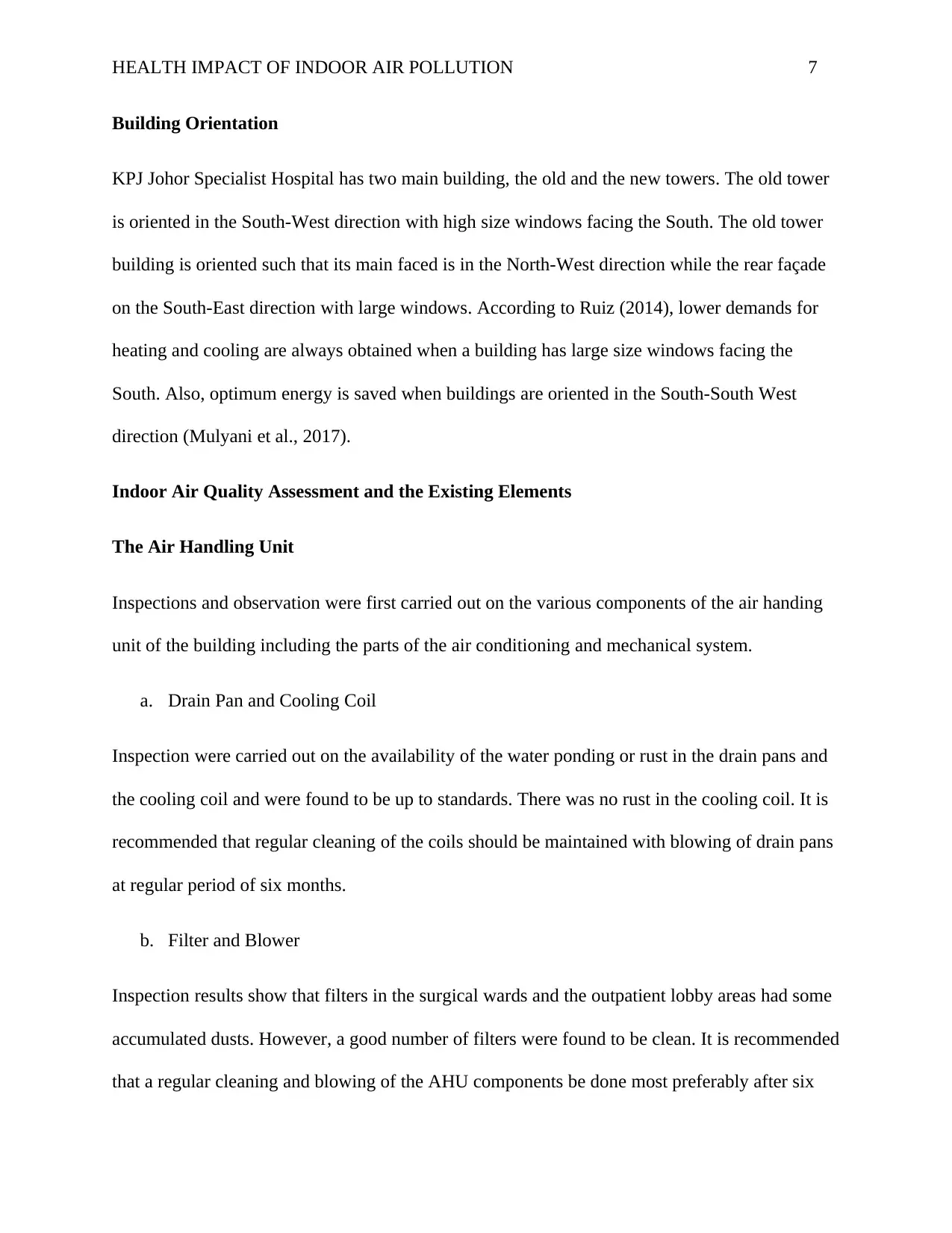
HEALTH IMPACT OF INDOOR AIR POLLUTION 7
Building Orientation
KPJ Johor Specialist Hospital has two main building, the old and the new towers. The old tower
is oriented in the South-West direction with high size windows facing the South. The old tower
building is oriented such that its main faced is in the North-West direction while the rear façade
on the South-East direction with large windows. According to Ruiz (2014), lower demands for
heating and cooling are always obtained when a building has large size windows facing the
South. Also, optimum energy is saved when buildings are oriented in the South-South West
direction (Mulyani et al., 2017).
Indoor Air Quality Assessment and the Existing Elements
The Air Handling Unit
Inspections and observation were first carried out on the various components of the air handing
unit of the building including the parts of the air conditioning and mechanical system.
a. Drain Pan and Cooling Coil
Inspection were carried out on the availability of the water ponding or rust in the drain pans and
the cooling coil and were found to be up to standards. There was no rust in the cooling coil. It is
recommended that regular cleaning of the coils should be maintained with blowing of drain pans
at regular period of six months.
b. Filter and Blower
Inspection results show that filters in the surgical wards and the outpatient lobby areas had some
accumulated dusts. However, a good number of filters were found to be clean. It is recommended
that a regular cleaning and blowing of the AHU components be done most preferably after six
Building Orientation
KPJ Johor Specialist Hospital has two main building, the old and the new towers. The old tower
is oriented in the South-West direction with high size windows facing the South. The old tower
building is oriented such that its main faced is in the North-West direction while the rear façade
on the South-East direction with large windows. According to Ruiz (2014), lower demands for
heating and cooling are always obtained when a building has large size windows facing the
South. Also, optimum energy is saved when buildings are oriented in the South-South West
direction (Mulyani et al., 2017).
Indoor Air Quality Assessment and the Existing Elements
The Air Handling Unit
Inspections and observation were first carried out on the various components of the air handing
unit of the building including the parts of the air conditioning and mechanical system.
a. Drain Pan and Cooling Coil
Inspection were carried out on the availability of the water ponding or rust in the drain pans and
the cooling coil and were found to be up to standards. There was no rust in the cooling coil. It is
recommended that regular cleaning of the coils should be maintained with blowing of drain pans
at regular period of six months.
b. Filter and Blower
Inspection results show that filters in the surgical wards and the outpatient lobby areas had some
accumulated dusts. However, a good number of filters were found to be clean. It is recommended
that a regular cleaning and blowing of the AHU components be done most preferably after six
Paraphrase This Document
Need a fresh take? Get an instant paraphrase of this document with our AI Paraphraser
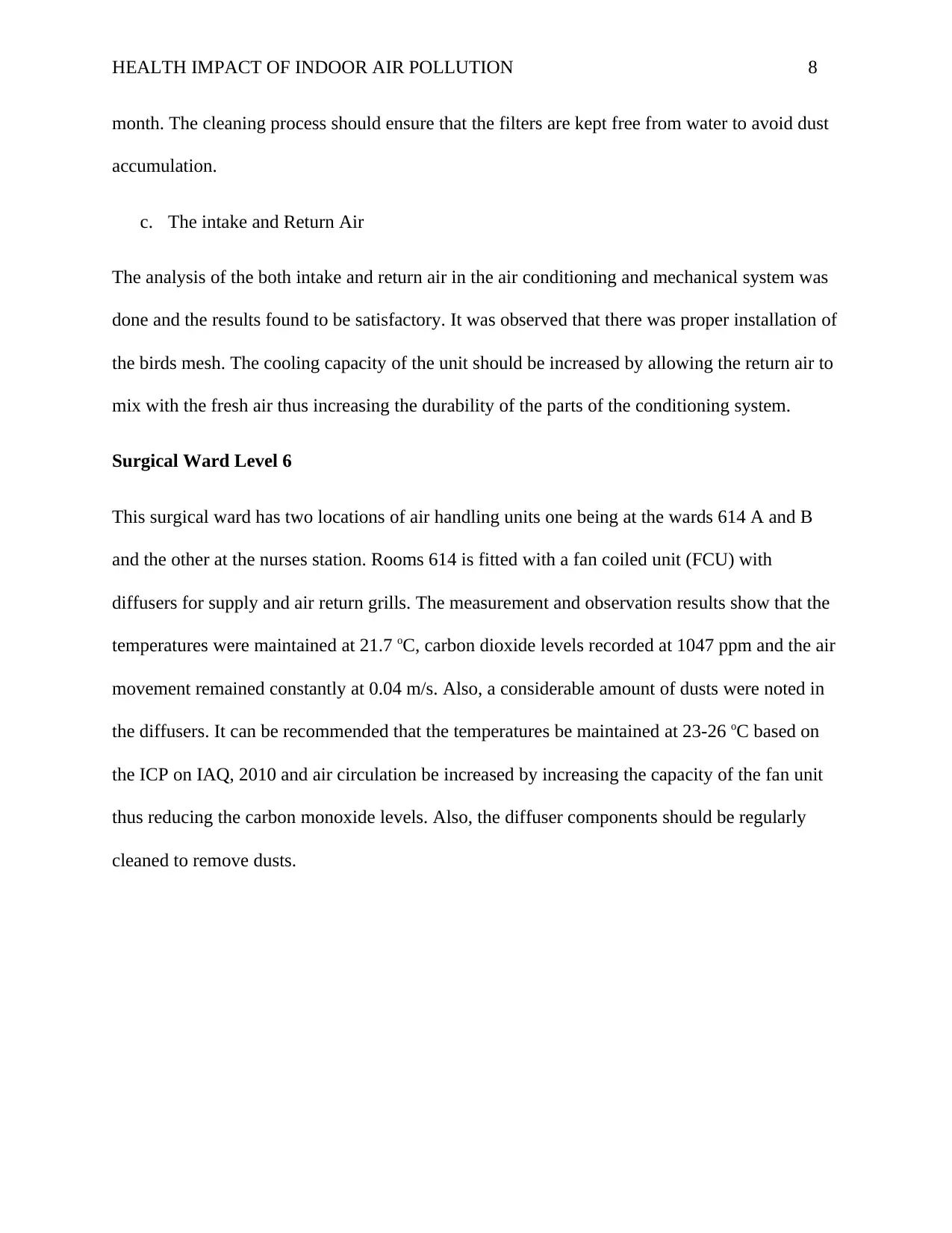
HEALTH IMPACT OF INDOOR AIR POLLUTION 8
month. The cleaning process should ensure that the filters are kept free from water to avoid dust
accumulation.
c. The intake and Return Air
The analysis of the both intake and return air in the air conditioning and mechanical system was
done and the results found to be satisfactory. It was observed that there was proper installation of
the birds mesh. The cooling capacity of the unit should be increased by allowing the return air to
mix with the fresh air thus increasing the durability of the parts of the conditioning system.
Surgical Ward Level 6
This surgical ward has two locations of air handling units one being at the wards 614 A and B
and the other at the nurses station. Rooms 614 is fitted with a fan coiled unit (FCU) with
diffusers for supply and air return grills. The measurement and observation results show that the
temperatures were maintained at 21.7 oC, carbon dioxide levels recorded at 1047 ppm and the air
movement remained constantly at 0.04 m/s. Also, a considerable amount of dusts were noted in
the diffusers. It can be recommended that the temperatures be maintained at 23-26 oC based on
the ICP on IAQ, 2010 and air circulation be increased by increasing the capacity of the fan unit
thus reducing the carbon monoxide levels. Also, the diffuser components should be regularly
cleaned to remove dusts.
month. The cleaning process should ensure that the filters are kept free from water to avoid dust
accumulation.
c. The intake and Return Air
The analysis of the both intake and return air in the air conditioning and mechanical system was
done and the results found to be satisfactory. It was observed that there was proper installation of
the birds mesh. The cooling capacity of the unit should be increased by allowing the return air to
mix with the fresh air thus increasing the durability of the parts of the conditioning system.
Surgical Ward Level 6
This surgical ward has two locations of air handling units one being at the wards 614 A and B
and the other at the nurses station. Rooms 614 is fitted with a fan coiled unit (FCU) with
diffusers for supply and air return grills. The measurement and observation results show that the
temperatures were maintained at 21.7 oC, carbon dioxide levels recorded at 1047 ppm and the air
movement remained constantly at 0.04 m/s. Also, a considerable amount of dusts were noted in
the diffusers. It can be recommended that the temperatures be maintained at 23-26 oC based on
the ICP on IAQ, 2010 and air circulation be increased by increasing the capacity of the fan unit
thus reducing the carbon monoxide levels. Also, the diffuser components should be regularly
cleaned to remove dusts.
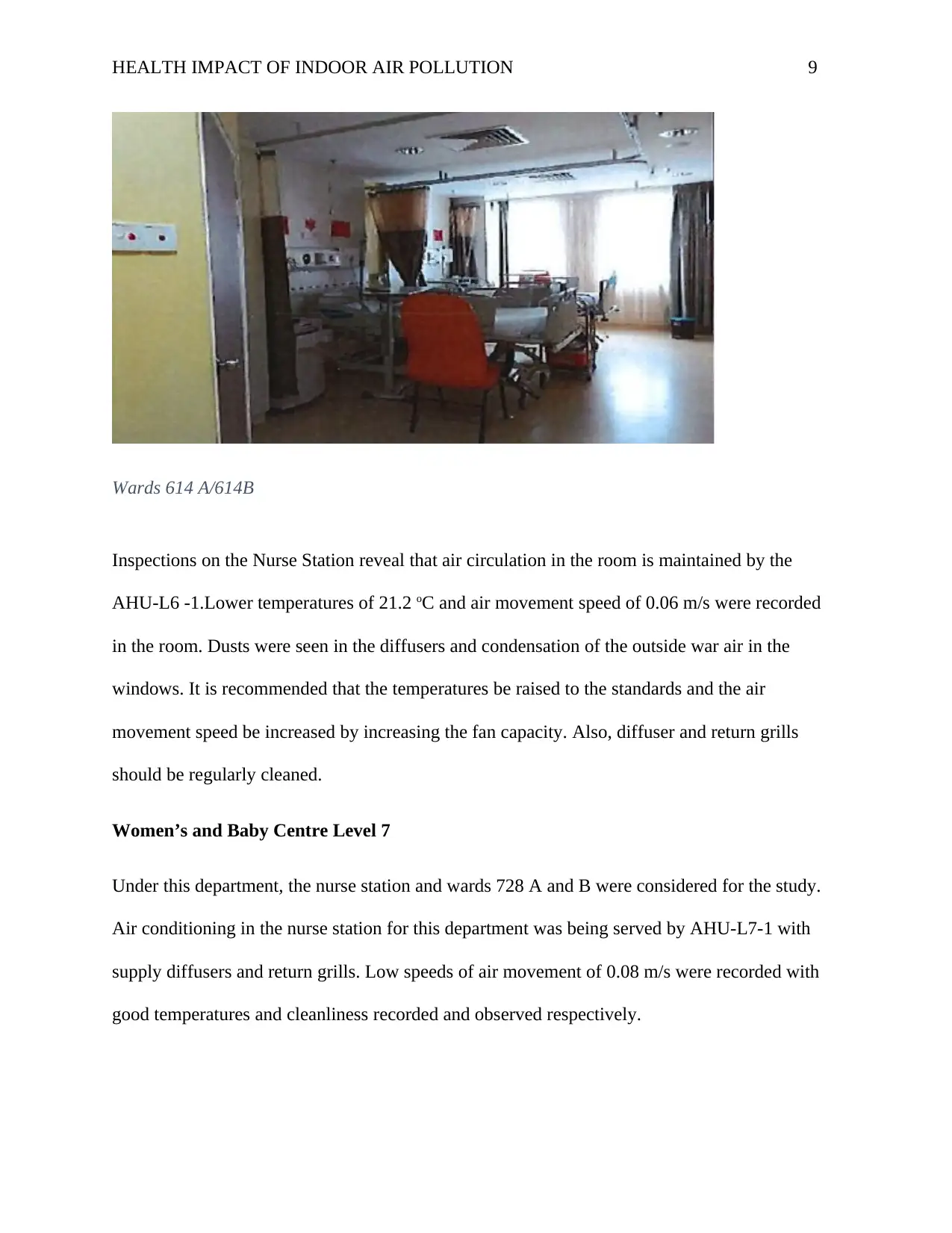
HEALTH IMPACT OF INDOOR AIR POLLUTION 9
Wards 614 A/614B
Inspections on the Nurse Station reveal that air circulation in the room is maintained by the
AHU-L6 -1.Lower temperatures of 21.2 oC and air movement speed of 0.06 m/s were recorded
in the room. Dusts were seen in the diffusers and condensation of the outside war air in the
windows. It is recommended that the temperatures be raised to the standards and the air
movement speed be increased by increasing the fan capacity. Also, diffuser and return grills
should be regularly cleaned.
Women’s and Baby Centre Level 7
Under this department, the nurse station and wards 728 A and B were considered for the study.
Air conditioning in the nurse station for this department was being served by AHU-L7-1 with
supply diffusers and return grills. Low speeds of air movement of 0.08 m/s were recorded with
good temperatures and cleanliness recorded and observed respectively.
Wards 614 A/614B
Inspections on the Nurse Station reveal that air circulation in the room is maintained by the
AHU-L6 -1.Lower temperatures of 21.2 oC and air movement speed of 0.06 m/s were recorded
in the room. Dusts were seen in the diffusers and condensation of the outside war air in the
windows. It is recommended that the temperatures be raised to the standards and the air
movement speed be increased by increasing the fan capacity. Also, diffuser and return grills
should be regularly cleaned.
Women’s and Baby Centre Level 7
Under this department, the nurse station and wards 728 A and B were considered for the study.
Air conditioning in the nurse station for this department was being served by AHU-L7-1 with
supply diffusers and return grills. Low speeds of air movement of 0.08 m/s were recorded with
good temperatures and cleanliness recorded and observed respectively.
⊘ This is a preview!⊘
Do you want full access?
Subscribe today to unlock all pages.

Trusted by 1+ million students worldwide
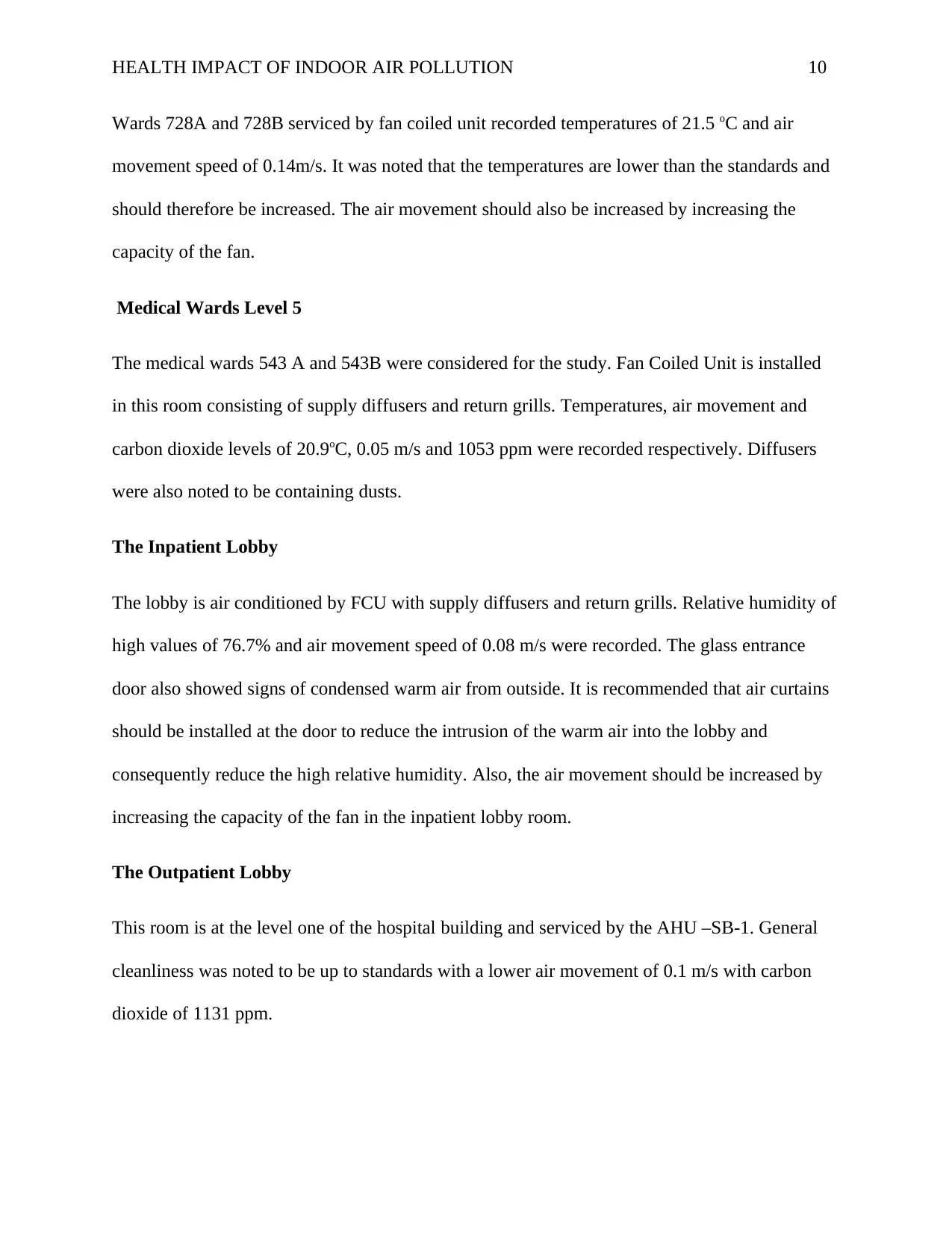
HEALTH IMPACT OF INDOOR AIR POLLUTION 10
Wards 728A and 728B serviced by fan coiled unit recorded temperatures of 21.5 oC and air
movement speed of 0.14m/s. It was noted that the temperatures are lower than the standards and
should therefore be increased. The air movement should also be increased by increasing the
capacity of the fan.
Medical Wards Level 5
The medical wards 543 A and 543B were considered for the study. Fan Coiled Unit is installed
in this room consisting of supply diffusers and return grills. Temperatures, air movement and
carbon dioxide levels of 20.9oC, 0.05 m/s and 1053 ppm were recorded respectively. Diffusers
were also noted to be containing dusts.
The Inpatient Lobby
The lobby is air conditioned by FCU with supply diffusers and return grills. Relative humidity of
high values of 76.7% and air movement speed of 0.08 m/s were recorded. The glass entrance
door also showed signs of condensed warm air from outside. It is recommended that air curtains
should be installed at the door to reduce the intrusion of the warm air into the lobby and
consequently reduce the high relative humidity. Also, the air movement should be increased by
increasing the capacity of the fan in the inpatient lobby room.
The Outpatient Lobby
This room is at the level one of the hospital building and serviced by the AHU –SB-1. General
cleanliness was noted to be up to standards with a lower air movement of 0.1 m/s with carbon
dioxide of 1131 ppm.
Wards 728A and 728B serviced by fan coiled unit recorded temperatures of 21.5 oC and air
movement speed of 0.14m/s. It was noted that the temperatures are lower than the standards and
should therefore be increased. The air movement should also be increased by increasing the
capacity of the fan.
Medical Wards Level 5
The medical wards 543 A and 543B were considered for the study. Fan Coiled Unit is installed
in this room consisting of supply diffusers and return grills. Temperatures, air movement and
carbon dioxide levels of 20.9oC, 0.05 m/s and 1053 ppm were recorded respectively. Diffusers
were also noted to be containing dusts.
The Inpatient Lobby
The lobby is air conditioned by FCU with supply diffusers and return grills. Relative humidity of
high values of 76.7% and air movement speed of 0.08 m/s were recorded. The glass entrance
door also showed signs of condensed warm air from outside. It is recommended that air curtains
should be installed at the door to reduce the intrusion of the warm air into the lobby and
consequently reduce the high relative humidity. Also, the air movement should be increased by
increasing the capacity of the fan in the inpatient lobby room.
The Outpatient Lobby
This room is at the level one of the hospital building and serviced by the AHU –SB-1. General
cleanliness was noted to be up to standards with a lower air movement of 0.1 m/s with carbon
dioxide of 1131 ppm.
Paraphrase This Document
Need a fresh take? Get an instant paraphrase of this document with our AI Paraphraser
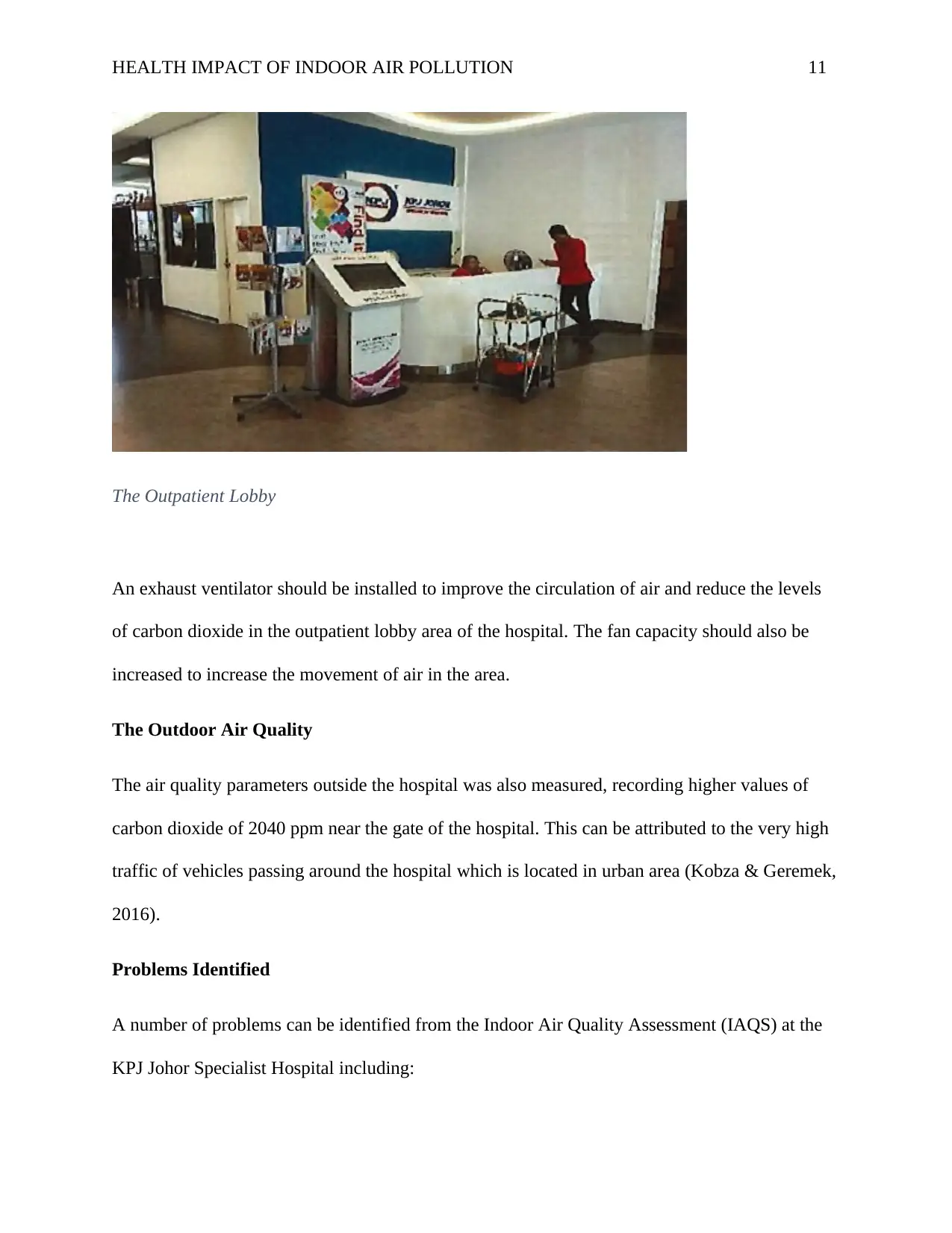
HEALTH IMPACT OF INDOOR AIR POLLUTION 11
The Outpatient Lobby
An exhaust ventilator should be installed to improve the circulation of air and reduce the levels
of carbon dioxide in the outpatient lobby area of the hospital. The fan capacity should also be
increased to increase the movement of air in the area.
The Outdoor Air Quality
The air quality parameters outside the hospital was also measured, recording higher values of
carbon dioxide of 2040 ppm near the gate of the hospital. This can be attributed to the very high
traffic of vehicles passing around the hospital which is located in urban area (Kobza & Geremek,
2016).
Problems Identified
A number of problems can be identified from the Indoor Air Quality Assessment (IAQS) at the
KPJ Johor Specialist Hospital including:
The Outpatient Lobby
An exhaust ventilator should be installed to improve the circulation of air and reduce the levels
of carbon dioxide in the outpatient lobby area of the hospital. The fan capacity should also be
increased to increase the movement of air in the area.
The Outdoor Air Quality
The air quality parameters outside the hospital was also measured, recording higher values of
carbon dioxide of 2040 ppm near the gate of the hospital. This can be attributed to the very high
traffic of vehicles passing around the hospital which is located in urban area (Kobza & Geremek,
2016).
Problems Identified
A number of problems can be identified from the Indoor Air Quality Assessment (IAQS) at the
KPJ Johor Specialist Hospital including:
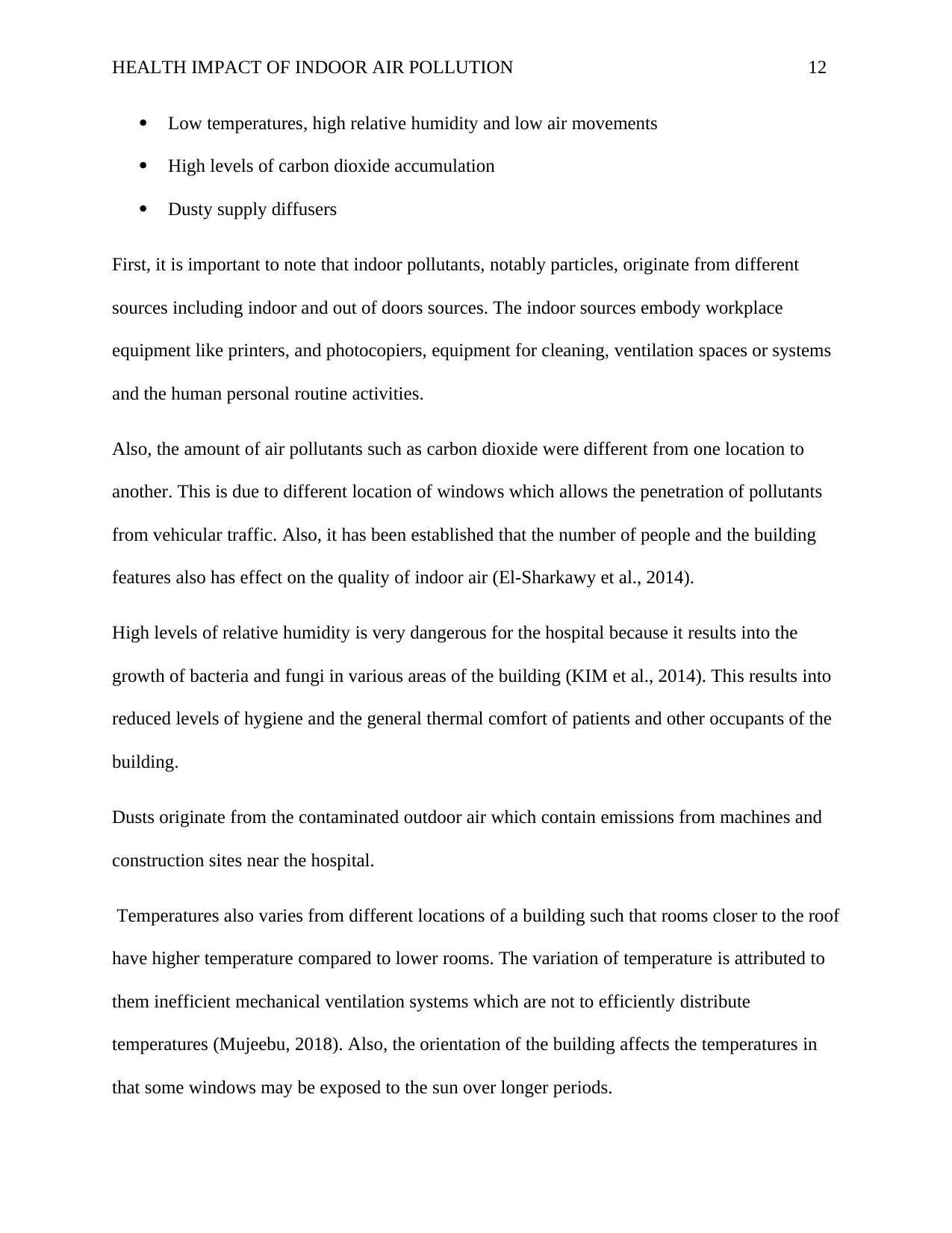
HEALTH IMPACT OF INDOOR AIR POLLUTION 12
Low temperatures, high relative humidity and low air movements
High levels of carbon dioxide accumulation
Dusty supply diffusers
First, it is important to note that indoor pollutants, notably particles, originate from different
sources including indoor and out of doors sources. The indoor sources embody workplace
equipment like printers, and photocopiers, equipment for cleaning, ventilation spaces or systems
and the human personal routine activities.
Also, the amount of air pollutants such as carbon dioxide were different from one location to
another. This is due to different location of windows which allows the penetration of pollutants
from vehicular traffic. Also, it has been established that the number of people and the building
features also has effect on the quality of indoor air (El-Sharkawy et al., 2014).
High levels of relative humidity is very dangerous for the hospital because it results into the
growth of bacteria and fungi in various areas of the building (KIM et al., 2014). This results into
reduced levels of hygiene and the general thermal comfort of patients and other occupants of the
building.
Dusts originate from the contaminated outdoor air which contain emissions from machines and
construction sites near the hospital.
Temperatures also varies from different locations of a building such that rooms closer to the roof
have higher temperature compared to lower rooms. The variation of temperature is attributed to
them inefficient mechanical ventilation systems which are not to efficiently distribute
temperatures (Mujeebu, 2018). Also, the orientation of the building affects the temperatures in
that some windows may be exposed to the sun over longer periods.
Low temperatures, high relative humidity and low air movements
High levels of carbon dioxide accumulation
Dusty supply diffusers
First, it is important to note that indoor pollutants, notably particles, originate from different
sources including indoor and out of doors sources. The indoor sources embody workplace
equipment like printers, and photocopiers, equipment for cleaning, ventilation spaces or systems
and the human personal routine activities.
Also, the amount of air pollutants such as carbon dioxide were different from one location to
another. This is due to different location of windows which allows the penetration of pollutants
from vehicular traffic. Also, it has been established that the number of people and the building
features also has effect on the quality of indoor air (El-Sharkawy et al., 2014).
High levels of relative humidity is very dangerous for the hospital because it results into the
growth of bacteria and fungi in various areas of the building (KIM et al., 2014). This results into
reduced levels of hygiene and the general thermal comfort of patients and other occupants of the
building.
Dusts originate from the contaminated outdoor air which contain emissions from machines and
construction sites near the hospital.
Temperatures also varies from different locations of a building such that rooms closer to the roof
have higher temperature compared to lower rooms. The variation of temperature is attributed to
them inefficient mechanical ventilation systems which are not to efficiently distribute
temperatures (Mujeebu, 2018). Also, the orientation of the building affects the temperatures in
that some windows may be exposed to the sun over longer periods.
⊘ This is a preview!⊘
Do you want full access?
Subscribe today to unlock all pages.

Trusted by 1+ million students worldwide
1 out of 16
Related Documents
Your All-in-One AI-Powered Toolkit for Academic Success.
+13062052269
info@desklib.com
Available 24*7 on WhatsApp / Email
![[object Object]](/_next/static/media/star-bottom.7253800d.svg)
Unlock your academic potential
Copyright © 2020–2025 A2Z Services. All Rights Reserved. Developed and managed by ZUCOL.





